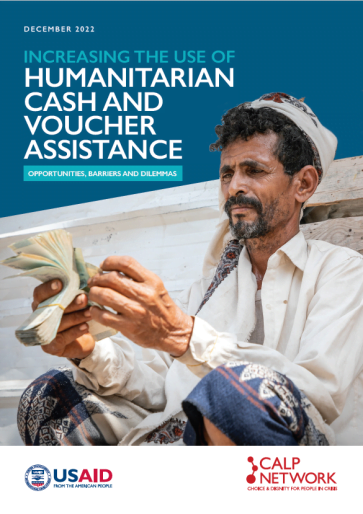Increasing the Use of Humanitarian Cash and Voucher Assistance: Opportunities, Barriers and Dilemmas
What’s in the report
The use of cash and voucher assistance (CVA) has grown rapidly in recent years, nearly doubling as a proportion of international humanitarian assistance since 2016 and now accounting for approximately 19%. Yet it is clear that there is potential to increase the use of CVA significantly more.
The research found that:
- If CVA were delivered wherever feasible and appropriate, it could account for at least 30% and up to 50% of global humanitarian assistance.
- The challenges to scaling CVA were examined with a focus on three countries – Yemen, Zimbabwe and the Philippines. The research found that major challenges to further scaling CVA were varied and numerous, from overall funding availability to the extent of harmonisation of CVA approaches to the availability of financial services.
- There is no single untapped reservoir to unlock the potential of CVA. The single biggest volume of aid with such restrictions is food aid from ‘Title II’ of the US Farm Bill and is often perceived as the only significant obstacle to increasing CVA. However, it was found that if the entire Title II budget was switched to CVA, total global volumes of CVA in 2017 would have been 21% rather than 15% of total international humanitarian assistance. This is significant but is still far short of the potential estimated by GPPi (37-42%) and the 30% figure calculated in this report.
- The increasing use of CVA is putting pressure on the humanitarian system to change and at the same time, the system requires changes to scale up CVA – there is clear pressure in both directions.
The pace of growth in the use of CVA is slowing, yet we are far from levels that would be achieved if CVA is used wherever and whenever appropriate. This study unpacks the potential – and the barriers the humanitarian community needs to overcome – to fully realise CVA as an effective tool to respond more effectively to the preferences of people in contexts of crisis.
Methodology
The research conducted interviews with 10 non-operational CVA actors (donor agencies, global coordination bodies and Cash Working Group coordinators) and 22 operational agencies. Predominantly, the operational agencies were selected from the three sectors that form the bulk of CVA (food security/livelihoods, shelter/NFI and WASH). However, it was seen as important also to include some representatives from other sectors where CVA is not (yet) an important modality, such as health.
To develop an overall figure on the potential volume of CVA, data was combined from CALP’s and DI’s data collection and calculations, agencies shared and public quantitative targets for CVA. Proxy targets were identified for other agencies, based on the assessments made by key informants. For organizations without any information on CVA targets, we added actual volumes of CVA implemented in 2021.
Next steps
Whilst this report looked at the potential to scale CVA, a sister report Where next? The evolving landscape of cash and voucher policies examined the policy gaps and opportunities to improve in this area. Together, the reports provide new insights into what is possible, the complex web of policies that influence the humanitarian system and the impediments to change.
A third paper People-focused, effective aid: The urgent need to accelerate progress on cash and voucher assistance for people in crisis summarizes the essence of the two reports and concludes that there is an urgent need for a new policy direction.
We would encourage those whose work involves supporting people in crisis to continue engaging in a dialogue about the future of CVA – and establish and/or renew CVA commitments so that we do not miss this opportunity to make a difference for people affected by crisis. If you would like to stay abreast of any formal events of developments, please sign up to receive emails from the CALP Network.



